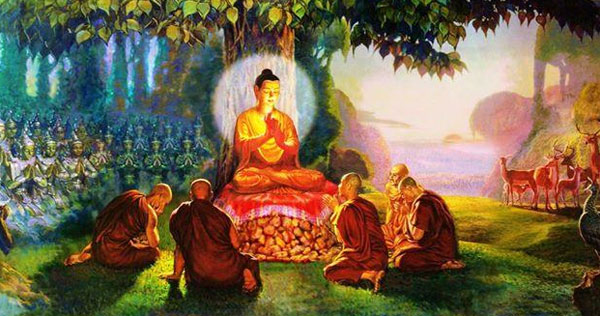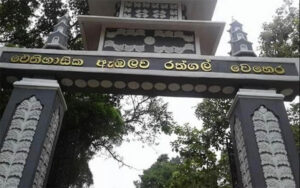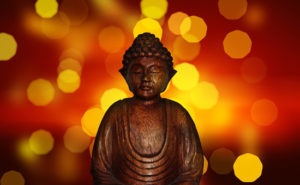
A Buddha’s name emerged in the world after a long time. This is clearly demonstrated in the stanzas of the Dhamma verse such as “Buddodpadhova Dullabho” or “Kichjo Buddhanang Uppadho”. The Buddha is coming to the world to cleanse the human mind and release it from all its misery.
The arrival of the Buddha will take place during a period when the number of people is not more than one hundred thousand and not less than one hundred. It is for this reason that all the Buddhas who were born from Deepankara Buddha to Kashyapa Buddha were born during the thousands of years of life.
However, due to the delay in the maturation of the Buddha Dhamma (Buddha Dhamma), Gautama Buddha was delayed. Accordingly, the birth took place during the hundred years of the supreme life of the people, since the passing of that age does not give the time for the birth of Buddha. The coming of the Gautama Buddha was a very difficult period, and it is difficult to imagine a super pillar in the midst of a fiery flame.
Gautama Buddha had only 45 years to perform his services. In that short time, He spent a long time doing all the services. He did so through time management. They divided their precious time into five parts and launched daily routines and services. Buddhism’s daily routine, or schedule, is very deep. It is so complex that no one else can. It is hard to imagine such a sacrifice for the blind. However, a Buddha emerges with the pure intention of giving the world animal comforts with the sacrifice of life. It can be considered a timetable for the Buddha. That day’s routine is,
Prabhat Kis (Predestined),
Backward Kis (Post-Buddhist),
Forerunner (First Go Function),
Medium Kis (Central Function) and
Pasluyam kis (post-work).
They worked 24 hours a day, using the above-mentioned method and working for the world animal. Prabhat Kisa is the first part. It is the morning, or the early morning. Accordingly pre-work in the morning. Noon-eating and stinking will occur. The next day is the afternoon work. Ie. The first part of the evening, such as chanting dhamma for the monks until sunset, providing karma charades for each bhikkhu, and taking a moment to relax. The second part of the afternoon will be followed by a discreet look at the worthy ones for the Dhamma Enlightenment.
Periyam is a time for bathing in the evening and coming to rest in the monastery, solving the problems of the monks and providing them with the necessary facilities. Medium Kis is a medium term. That time provided opportunities for the goddesses to solve their problems. Pasluyam ki is the late night. It is divided into three parts, the first part of which is pure breathing, meditation, and the second part, which is a two-hour exhaustion from Saiya Sayya, and the third part, which is about the world of the Buddha who is awakened by the end of the post-apocalyptic period.
The character of the Buddha shows how this daily routine, or schedule, was changed for the sake of its mother. That is, in the time of Siddhartha Kumara his mother was Mahamaya Devi. Thottisa was born in the Divine World in the seven days after Mahamaya Devi gave birth to her son. It is a remarkable incident in the character of the Buddha that the Buddha came to the world as a duty to his mother. It gives us insight into the Buddha’s sacrifice for his mother. It is the greatest and most significant message about parental care for the entire animal community.
At the root of the Buddhist gandabbha rukkha, tautisa came to heaven for the seventh poisoning of the Yama masses in order to clear the dimension of the martyrs. It happens on a full moon day. Tavatisa Deva arrived in the world and preached the Vijayam Bana (Abhidhamma Dhamma) to the Chief God of the Mother Goddess. It is said that Tauthissa lived in heaven for three months. In the 45 years of the Buddha, the Vasya dwelling begins with the veneration of the Baranasa. It ends in the village of Baeluwa near Valiyanuwara.
After three months, the Buddha returned to the city of Sankasapura. The masses waited for the arrival of the Buddha. Many people saw the beauty of the Buddha and prayed that it was a Buddha. The Buddha’s character can be understood as a miraculous occurrence. Even the Buddha’s support and sacrifice to his parents will be an example for all. Even the average trained animal can imitate it and treat its parents.
The fourth week, “Chathutthang Cha Ratanaurang”, is said to be sitting in the house of Ruwan in the north-west of the Bodhi and meditating on Abhidhamma. It is an indelible monument in the character of Buddha that Tauthissa came to the world and preached to his mother, the Mother Divine King, using the seventh poison of the deep Dhamma. Throughout the lifetime of the world animal sacrifice has been the service of the whole world, sharing the time daily. For forty-five years without sacrificing even the slightest amount of time, he devoted his life to the worldly life of this world, the Nirvana in the Hereafter. One of the hallmarks of a noble teacher is that his parents are not forgotten along the way.





